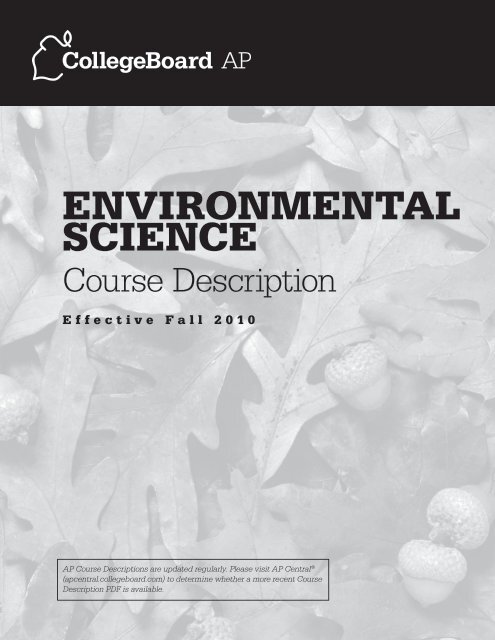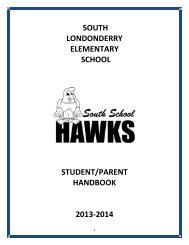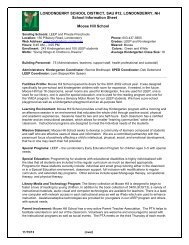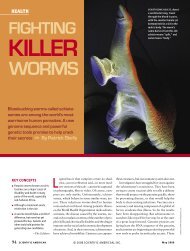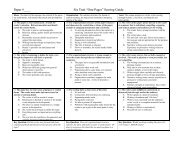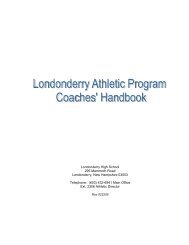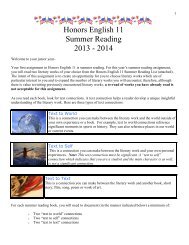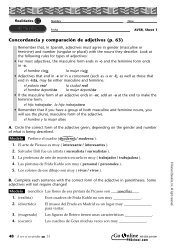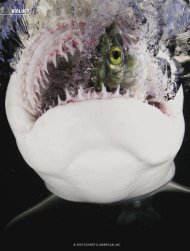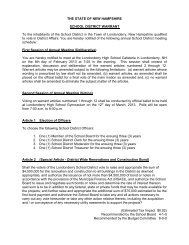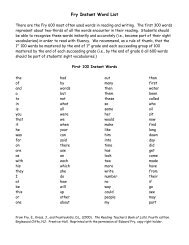eNvIRoNmeNtal sCIeNCe - College Board
eNvIRoNmeNtal sCIeNCe - College Board
eNvIRoNmeNtal sCIeNCe - College Board
- No tags were found...
You also want an ePaper? Increase the reach of your titles
YUMPU automatically turns print PDFs into web optimized ePapers that Google loves.
environmentalscienceCourse DescriptionE f f e c t i v e F a l l 2 0 1 0AP Course Descriptions are updated regularly. Please visit AP Central ®(apcentral.collegeboard.com) to determine whether a more recent CourseDescription PDF is available.
The <strong>College</strong> <strong>Board</strong>The <strong>College</strong> <strong>Board</strong> is a not-for-profit membership association whose mission is to connect studentsto college success and opportunity. Founded in 1900, the association is composed of more than5,600 schools, colleges, universities, and other educational organizations. Each year, the <strong>College</strong> <strong>Board</strong>serves seven million students and their parents, 23,000 high schools, and 3,800 colleges throughmajor programs and services in college admissions, guidance, assessment, financial aid, enrollment,and teaching and learning. Among its best-known programs are the SAT ® , the PSAT/NMSQT ® ,and the Advanced Placement Program ® (AP ® ). The <strong>College</strong> <strong>Board</strong> is committed to the principles ofexcellence and equity, and that commitment is embodied in all of its programs, services, activities,and concerns.For further information visit www.collegeboard.com.The <strong>College</strong> <strong>Board</strong> and the Advanced Placement Program encourage teachers, AP Coordinators,and school administrators to make equitable access a guiding principle for their AP programs. The<strong>College</strong> <strong>Board</strong> is committed to the principle that all students deserve an opportunity to participate inrigorous and academically challenging courses and programs. All students who are willing to acceptthe challenge of a rigorous academic curriculum should be considered for admission to AP courses.The <strong>Board</strong> encourages the elimination of barriers that restrict access to AP courses for students fromethnic, racial, and socioeconomic groups that have been traditionally underrepresented in the APProgram. Schools should make every effort to ensure that their AP classes reflect the diversity of theirstudent population.© 2010 The <strong>College</strong> <strong>Board</strong>. All rights reserved. <strong>College</strong> <strong>Board</strong>, Advanced Placement Program, AP, AP Central, SAT, and the acornlogo are registered trademarks of the <strong>College</strong> <strong>Board</strong>. PSAT/NMSQT is a registered trademark of the <strong>College</strong> <strong>Board</strong> and NationalMerit Scholarship Corporation. All other products and services may be trademarks of their respective owners. Permission to usecopyrighted <strong>College</strong> <strong>Board</strong> materials may be requested online at: www.collegeboard.com/inquiry/cbpermit.html.
ContentsWelcome to the AP Program .. . . . . . . . . . . . . . . . . . . . . . . . . . . . . . . . . . . . . . . . . . . . . . . . 1AP Courses.. . . . . . . . . . . . . . . . . . . . . . . . . . . . . . . . . . . . . . . . . . . . . . . . . . . . . . . . . . . . 1AP Exams.. . . . . . . . . . . . . . . . . . . . . . . . . . . . . . . . . . . . . . . . . . . . . . . . . . . . . . . . . . . . . 1AP Course Audit. . . . . . . . . . . . . . . . . . . . . . . . . . . . . . . . . . . . . . . . . . . . . . . . . . . . . . . . 1AP Reading.. . . . . . . . . . . . . . . . . . . . . . . . . . . . . . . . . . . . . . . . . . . . . . . . . . . . . . . . . . . . 2AP Exam Grades.. . . . . . . . . . . . . . . . . . . . . . . . . . . . . . . . . . . . . . . . . . . . . . . . . . . . . . . 2Credit and Placement for AP Grades . . . . . . . . . . . . . . . . . . . . . . . . . . . . . . . . . . . . 3Setting Credit and Placement Policies for AP Grades .. . . . . . . . . . . . . . . . . . . . . . 3AP Environmental Science .. . . . . . . . . . . . . . . . . . . . . . . . . . . . . . . . . . . . . . . . . . . . . . . . . . 4Introduction .. . . . . . . . . . . . . . . . . . . . . . . . . . . . . . . . . . . . . . . . . . . . . . . . . . . . . . . . . . . 4The Course .. . . . . . . . . . . . . . . . . . . . . . . . . . . . . . . . . . . . . . . . . . . . . . . . . . . . . . . . . . . 4Prerequisites .. . . . . . . . . . . . . . . . . . . . . . . . . . . . . . . . . . . . . . . . . . . . . . . . . . . . . . . . 5Textbooks .. . . . . . . . . . . . . . . . . . . . . . . . . . . . . . . . . . . . . . . . . . . . . . . . . . . . . . . . . . 5Topic Outline .. . . . . . . . . . . . . . . . . . . . . . . . . . . . . . . . . . . . . . . . . . . . . . . . . . . . . . . 6Laboratory and Field Investigation . . . . . . . . . . . . . . . . . . . . . . . . . . . . . . . . . . . . . . . . 9Instructional Issues: Training, Funding, and Scheduling .. . . . . . . . . . . . . . . . . . . . 11The Exam . . . . . . . . . . . . . . . . . . . . . . . . . . . . . . . . . . . . . . . . . . . . . . . . . . . . . . . . . . . . 11Sample Multiple-Choice Questions .. . . . . . . . . . . . . . . . . . . . . . . . . . . . . . . . . . . . 12Answers to Multiple-Choice Questions . . . . . . . . . . . . . . . . . . . . . . . . . . . . . . . 16Sample Free-Response Questions .. . . . . . . . . . . . . . . . . . . . . . . . . . . . . . . . . . . . . 17Teacher Support.. . . . . . . . . . . . . . . . . . . . . . . . . . . . . . . . . . . . . . . . . . . . . . . . . . . . . . . . . . 21AP Central (apcentral.collegeboard.com).. . . . . . . . . . . . . . . . . . . . . . . . . . . . . . . . . 21AP Publications and Other Resources. . . . . . . . . . . . . . . . . . . . . . . . . . . . . . . . . . . . . 21Teacher’s Guides.. . . . . . . . . . . . . . . . . . . . . . . . . . . . . . . . . . . . . . . . . . . . . . . . . . . . 21Course Descriptions . . . . . . . . . . . . . . . . . . . . . . . . . . . . . . . . . . . . . . . . . . . . . . . . . 21Released Exams .. . . . . . . . . . . . . . . . . . . . . . . . . . . . . . . . . . . . . . . . . . . . . . . . . . . . 21© 2010 The <strong>College</strong> <strong>Board</strong>. Visit the <strong>College</strong> <strong>Board</strong> on the Web: www.collegeboard.com.i
Welcome to the AP ® ProgramFor over 50 years, the <strong>College</strong> <strong>Board</strong>’s Advanced Placement Program (AP) haspartnered with colleges, universities, and high schools to provide students with theopportunity to take college-level course work and exams while still in high school.Offering more than 30 different subjects, each culminating in a rigorous exam, APprovides motivated and academically prepared students with the opportunity to earncollege credit or placement and helps them stand out in the college admissionsprocess. Taught by dedicated, passionate AP teachers who bring cutting-edge contentknowledge and expert teaching skills to the classroom, AP courses help studentsdevelop the study skills, habits of mind, and critical thinking skills that they will needin college.AP is accepted by more than 3,600 colleges and universities worldwide for collegecredit, advanced placement, or both on the basis of successful AP Exam grades. Thisincludes over 90 percent of four-year institutions in the United States.More information about the AP Program is available at the back of this CourseDescription and at AP Central ® , the <strong>College</strong> <strong>Board</strong>’s online home for AP teachers(apcentral.collegeboard.com). Students can find more information at the AP studentsite (www.collegeboard.com/apstudents).AP CoursesMore than 30 AP courses in a wide variety of subject areas are now available. Acommittee of college faculty and master AP teachers designs each AP course to coverthe information, skills, and assignments found in the corresponding college course.AP ExamsEach AP course has a corresponding exam that participating schools worldwideadminister in May. Except for AP Studio Art, which is a portfolio assessment, each APExam contains a free-response section (essays, problem solving, oral responses, etc.)as well as multiple-choice questions.Written by a committee of college and university faculty and experienced APteachers, the AP Exam is the culmination of the AP course and provides students withthe opportunity to earn credit and/or placement in college. Exams are scored bycollege professors and experienced AP teachers using scoring standards developed bythe committee.AP Course AuditThe intent of the AP Course Audit is to provide secondary and higher educationconstituents with the assurance that an “AP” designation on a student’s transcript iscredible, meaning the AP Program has authorized a course that has met or exceededthe curricular requirements and classroom resources that demonstrate the academicrigor of a comparable college course. To receive authorization from the <strong>College</strong> <strong>Board</strong>to label a course “AP,” teachers must participate in the AP Course Audit. Coursesauthorized to use the “AP” designation are listed in the AP Course Ledger madeavailable to colleges and universities each fall. It is the school’s responsibility to ensurethat its AP Course Ledger entry accurately reflects the AP courses offered within eachacademic year.© 2010 The <strong>College</strong> <strong>Board</strong>. Visit the <strong>College</strong> <strong>Board</strong> on the Web: www.collegeboard.com.1
The AP Program unequivocally supports the principle that each individual schoolmust develop its own curriculum for courses labeled “AP.” Rather than mandating anyone curriculum for AP courses, the AP Course Audit instead provides each AP teacherwith a set of expectations that college and secondary school faculty nationwide haveestablished for college-level courses. AP teachers are encouraged to develop or maintaintheir own curriculum that either includes or exceeds each of these expectations;such courses will be authorized to use the “AP” designation. Credit for the success ofAP courses belongs to the individual schools and teachers that create powerful, locallydesigned AP curricula.Complete information about the AP Course Audit is available at www.collegeboard.com/apcourseaudit.AP ReadingAP Exams—with the exception of AP Studio Art, which is a portfolio assessment—consist of dozens of multiple-choice questions scored by machine, and free-responsequestions scored at the annual AP Reading by thousands of college faculty and expertAP teachers. AP Readers use scoring standards developed by college and universityfaculty who teach the corresponding college course. The AP Reading offers educatorsboth significant professional development and the opportunity to network withcolleagues. For more information about the AP Reading, or to apply to serve as aReader, visit apcentral.collegeboard.com/readers.AP Exam GradesThe Readers’ scores on the free-response questions are combined with the results ofthe computer-scored multiple-choice questions; the weighted raw scores are summedto give a composite score. The composite score is then converted to a grade on AP’s5-point scale:AP GRADE QUALIFICATION5 Extremely well qualified4 Well qualified3 Qualified2 Possibly qualified1 No recommendationAP Exam grades of 5 are equivalent to A grades in the corresponding college course.AP Exam grades of 4 are equivalent to grades of A –, B+, and B in college. AP Examgrades of 3 are equivalent to grades of B –, C+, and C in college.2© 2010 The <strong>College</strong> <strong>Board</strong>. Visit the <strong>College</strong> <strong>Board</strong> on the Web: www.collegeboard.com.
Credit and Placement for AP GradesThousands of four-year colleges grant credit, placement, or both for qualifying AP Examgrades because these grades represent a level of achievement equivalent to that ofstudents who have taken the corresponding college course. This college-levelequivalency is ensured through several AP Program processes:• <strong>College</strong> faculty are involved in course and exam development and other AP activities.Currently, college faculty:• Serve as chairs and members of the committees that develop the CourseDescriptions and exams in each AP course.• Are responsible for standard setting and are involved in the evaluation of studentresponses at the AP Reading. The Chief Reader for each AP subject is a collegefaculty member.• Lead professional development seminars for new and experienced AP teachers.• Serve as the senior reviewers in the annual AP Course Audit, ensuring APteachers’ syllabi meet the curriculum guidelines of college-level courses.• AP courses and exams are reviewed and updated regularly based on the resultsof curriculum surveys at up to 200 colleges and universities, collaborations amongthe <strong>College</strong> <strong>Board</strong> and key educational and disciplinary organizations, and theinteractions of committee members with professional organizations in theirdiscipline.• Periodic college comparability studies are undertaken in which the performance ofcollege students on AP Exams is compared with that of AP students to confirm thatthe AP grade scale of 1 to 5 is properly aligned with current college standards.For more information about the role of colleges and universities in the AP Program,visit the Higher Ed Services section of the <strong>College</strong> <strong>Board</strong> Web site at professionals.collegeboard.com/higher-ed.Setting Credit and Placement Policies for AP GradesThe <strong>College</strong> <strong>Board</strong> Web site for education professionals has a section specifically forcolleges and universities that provides guidance in setting AP credit and placementpolicies. Additional resources, including links to AP research studies, released examquestions, and sample student responses at varying levels of achievement for each APExam are also available. Visit professionals.collegeboard.com/higher-ed/placement/ap.The “AP Credit Policy Info” online search tool provides links to credit and placementpolicies at more than 1,000 colleges and universities. This tool helps students find thecredit hours and/or advanced placement they may receive for qualifying exam gradeswithin each AP subject at a specified institution. AP Credit Policy Info is available atwww.collegeboard.com/ap/creditpolicy.© 2010 The <strong>College</strong> <strong>Board</strong>. Visit the <strong>College</strong> <strong>Board</strong> on the Web: www.collegeboard.com.3
AP Environmental ScienceI n t r o d u c t i o nThe AP Environmental Science course is designed to be the equivalent of a onesemester,introductory college course in environmental science. Unlike most otherintroductory-level college science courses, environmental science is offered from awide variety of departments, including geology, biology, environmental studies,environmental science, chemistry, and geography. Depending on the departmentoffering the course, different emphases are placed on various topics. Some courses arerigorous science courses that stress scientific principles and analysis and that ofteninclude a laboratory component; other courses emphasize the study of environmentalissues from a sociological or political perspective rather than a scientific one. TheAP Environmental Science course has been developed to be most like the former; assuch, it is intended to enable students to undertake, as first-year college students, amore advanced study of topics in environmental science or, alternatively, to fulfill abasic requirement for a laboratory science and thus free time for taking other courses.The AP Course Description and AP Exam have been prepared by environmentalscientists and educators who serve as members of the AP Environmental ScienceDevelopment Committee. In both breadth and level of detail, the content of the coursereflects what is found in many introductory college courses in environmental science.The exam is representative of such a course and therefore is considered appropriate forthe measurement of skills and knowledge in the field of environmental science.T h e C o u r s eThe goal of the AP Environmental Science course is to provide students with thescientific principles, concepts, and methodologies required to understand the interrelationshipsof the natural world, to identify and analyze environmental problems bothnatural and human-made, to evaluate the relative risks associated with these problems,and to examine alternative solutions for resolving or preventing them.Environmental science is interdisciplinary; it embraces a wide variety of topics fromdifferent areas of study. Yet there are several major unifying constructs, or themes,that cut across the many topics included in the study of environmental science. Thefollowing themes provide a foundation for the structure of the AP EnvironmentalScience course.1. Science is a process.• Science is a method of learning more about the world.• Science constantly changes the way we understand the world.2. Energy conversions underlie all ecological processes.• Energy cannot be created; it must come from somewhere.• As energy flows through systems, at each step more of it becomes unusable.4© 2010 The <strong>College</strong> <strong>Board</strong>. Visit the <strong>College</strong> <strong>Board</strong> on the Web: www.collegeboard.com.
3. The Earth itself is one interconnected system.• Natural systems change over time and space.• Biogeochemical systems vary in ability to recover from disturbances.4. Humans alter natural systems.• Humans have had an impact on the environment for millions of years.• Technology and population growth have enabled humans to increase both therate and scale of their impact on the environment.5. Environmental problems have a cultural and social context.• Understanding the role of cultural, social, and economic factors is vital to thedevelopment of solutions.6. Human survival depends on developing practices that will achieve sustainablesystems.• A suitable combination of conservation and development is required.• Management of common resources is essential.PrerequisitesThe AP Environmental Science course is an excellent option for any interested studentwho has completed two years of high school laboratory science—one year of lifescience and one year of physical science (for example, a year of biology and a year ofchemistry). Due to the quantitative analysis that is required in the course, studentsshould also have taken at least one year of algebra. Also desirable (but not necessary)is a course in earth science. Because of the prerequisites, AP Environmental Sciencewill usually be taken in either the junior or senior year.TextbooksA number of recently published textbooks are appropriate for college studentsenrolled in introductory courses in environmental science. Reviews of many suchtextbooks can be found by clicking on the Teachers’ Resources tab on the AP Centralhome page (apcentral.collegeboard.com). The AP Environmental Science teachershould examine a variety of textbooks and use one that will adequately cover thesuggested syllabus in a manner and style satisfactory to the teacher and the students.Among the major considerations to be used in choosing a text are depth and breadthof coverage, quality of illustrations, readability, clarity of presentation, value of end-ofchapterquestions, availability of other teaching aids, and the capacity to stimulatestudent interest. A recently published textbook should be chosen so as to ensure thatthe information it contains is current and accurate.School systems should recognize that the rapidly changing nature of environmentalscience requires regular updating of textbooks. While textbooks serve as valuablereferences, they cannot be exhaustive. Professional development—especially remainingcurrent with new discoveries, events, and conceptual trends—is one responsibility ofany AP teacher.© 2010 The <strong>College</strong> <strong>Board</strong>. Visit the <strong>College</strong> <strong>Board</strong> on the Web: www.collegeboard.com.5
Topic OutlineThe following outline of major topics serves to describe the scope of the AP EnvironmentalScience course and exam. The order of topics in the outline holds no specialsignificance, since there are many different sequences in which the topics can beappropriately addressed in the course. The percentage after each major topic headingshows the approximate proportion of multiple-choice questions on the exam thatpertain to that heading; thus, the percentage also indicates the relative emphasis thatshould be placed on the topics in the course.I. Earth Systems and Resources (10–15%)A. Earth Science Concepts(Geologic time scale; plate tectonics, earthquakes, volcanism; seasons; solarintensity and latitude)B. The Atmosphere(Composition; structure; weather and climate; atmospheric circulation andthe Coriolis Effect; atmosphere–ocean interactions; ENSO)C. Global Water Resources and Use(Freshwater/saltwater; ocean circulation; agricultural, industrial, and domesticuse; surface and groundwater issues; global problems; conservation)D. Soil and Soil Dynamics(Rock cycle; formation; composition; physical and chemical properties; mainsoil types; erosion and other soil problems; soil conservation)II. The Living World (10–15%)A. Ecosystem Structure(Biological populations and communities; ecological niches; interactionsamong species; keystone species; species diversity and edge effects; majorterrestrial and aquatic biomes)B. Energy Flow(Photosynthesis and cellular respiration; food webs and trophic levels;ecological pyramids)C. Ecosystem Diversity(Biodiversity; natural selection; evolution; ecosystem services)D. Natural Ecosystem Change(Climate shifts; species movement; ecological succession)E. Natural Biogeochemical Cycles(Carbon, nitrogen, phosphorus, sulfur, water, conservation of matter)6© 2010 The <strong>College</strong> <strong>Board</strong>. Visit the <strong>College</strong> <strong>Board</strong> on the Web: www.collegeboard.com.
III. Population (10–15%)A. Population Biology Concepts(Population ecology; carrying capacity; reproductive strategies; survivorship)B. Human Population1. Human population dynamics(Historical population sizes; distribution; fertility rates; growth rates anddoubling times; demographic transition; age-structure diagrams)2. Population size(Strategies for sustainability; case studies; national policies)3. Impacts of population growth(Hunger; disease; economic effects; resource use; habitat destruction)IV. Land and Water Use (10–15%)A. Agriculture1. Feeding a growing population(Human nutritional requirements; types of agriculture; Green Revolution;genetic engineering and crop production; deforestation; irrigation;sustainable agriculture)2. Controlling pests(Types of pesticides; costs and benefits of pesticide use; integrated pestmanagement; relevant laws)B. Forestry(Tree plantations; old growth forests; forest fires; forest management;national forests)C. Rangelands(Overgrazing; deforestation; desertification; rangeland management; federalrangelands)D. Other Land Use1. Urban land development(Planned development; suburban sprawl; urbanization)2. Transportation infrastructure(Federal highway system; canals and channels; roadless areas; ecosystemimpacts)3. Public and federal lands(Management; wilderness areas; national parks; wildlife refuges; forests;wetlands)4. Land conservation options(Preservation; remediation; mitigation; restoration)5. Sustainable land-use strategiesE. Mining(Mineral formation; extraction; global reserves; relevant laws and treaties)© 2010 The <strong>College</strong> <strong>Board</strong>. Visit the <strong>College</strong> <strong>Board</strong> on the Web: www.collegeboard.com.7
F. Fishing(Fishing techniques; overfishing; aquaculture; relevant laws and treaties)G. Global Economics(Globalization; World Bank; Tragedy of the Commons; relevant laws andtreaties)V. Energy Resources and Consumption (10–15%)A. Energy Concepts(Energy forms; power; units; conversions; Laws of Thermo dynamics)B. Energy Consumption1. History(Industrial Revolution; exponential growth; energy crisis)2. Present global energy use3. Future energy needsC. Fossil Fuel Resources and Use(Formation of coal, oil, and natural gas; extraction/purification methods;world reserves and global demand; synfuels; environmental advantages/disadvantages of sources)D. Nuclear Energy(Nuclear fission process; nuclear fuel; electricity production; nuclear reactortypes; environmental advantages/disadvantages; safety issues; radiation andhuman health; radioactive wastes; nuclear fusion)E. Hydroelectric Power(Dams; flood control; salmon; silting; other impacts)F. Energy Conservation(Energy efficiency; CAFE standards; hybrid electric vehicles; mass transit)G. Renewable Energy(Solar energy; solar electricity; hydrogen fuel cells; biomass; wind energy;small-scale hydroelectric; ocean waves and tidal energy; geothermal;environmental advantages/disadvantages)VI. Pollution (25–30%)A. Pollution Types1. Air pollution(Sources—primary and secondary; major air pollutants; measurementunits; smog; acid deposition—causes and effects; heat islands andtemperature inversions; indoor air pollution; remediation and reductionstrategies; Clean Air Act and other relevant laws)2. Noise pollution(Sources; effects; control measures)3. Water pollution(Types; sources, causes, and effects; cultural eutrophication; groundwaterpollution; maintaining water quality; water purification; sewagetreatment/septic systems; Clean Water Act and other relevant laws)8© 2010 The <strong>College</strong> <strong>Board</strong>. Visit the <strong>College</strong> <strong>Board</strong> on the Web: www.collegeboard.com.
4. Solid waste(Types; disposal; reduction)B. Impacts on the Environment and Human Health1. Hazards to human health(Environmental risk analysis; acute and chronic effects; dose-responserelationships; air pollutants; smoking and other risks)2. Hazardous chemicals in the environment(Types of hazardous waste; treatment/disposal of hazardous waste;cleanup of contaminated sites; biomagnification; relevant laws)C. Economic Impacts(Cost-benefit analysis; externalities; marginal costs; sustainability)VII. Global Change (10–15%)A. Stratospheric Ozone(Formation of stratospheric ozone; ultraviolet radiation; causes of ozonedepletion; effects of ozone depletion; strategies for reducing ozonedepletion; relevant laws and treaties)B. Global Warming(Greenhouse gases and the greenhouse effect; impacts and consequences ofglobal warming; reducing climate change; relevant laws and treaties)C. Loss of Biodiversity1. Habitat loss; overuse; pollution; introduced species; endangered andextinct species2. Maintenance through conservation3. Relevant laws and treatiesL a b o r a t o r y a n d F i e l dI n v e s t i g a t i o nBecause it is designed to be a course in environmental science rather than environmentalstudies, the AP Environmental Science course must include a stronglaboratory and field investigation component. The goal of this component is tocomplement the classroom portion of the course by allowing students to learn aboutthe environment through firsthand observation. Experiences both in the laboratoryand in the field provide students with important opportunities to test concepts andprinciples that are introduced in the classroom, explore specific problems with a depthnot easily achieved otherwise, and gain an awareness of the importance of confoundingvariables that exist in the “real world.” In these experiences students can employ alternativelearning styles to reinforce fundamental concepts and principles. Because allstudents have a stake in the future of their environment, such activities can motivatestudents to study environmental science in greater depth. <strong>College</strong>s often requirestudents to present their laboratory materials from AP science courses beforegranting college credit for laboratory, so students should be encouraged toretain their laboratory notebooks, reports, and other materials.© 2010 The <strong>College</strong> <strong>Board</strong>. Visit the <strong>College</strong> <strong>Board</strong> on the Web: www.collegeboard.com.9
Laboratory and field investigation activities in the course should be diverse. Asexamples, students can acquire skills in specific techniques and procedures (such ascollecting and analyzing water samples), conduct a long-term study of some localsystem or environmental problem (such as the pollution of a nearby stream), analyze areal data set (such as mean global temperatures over the past 100 years), and visit alocal public facility (such as a water-treatment plant).Although there is a great diversity in the laboratory and field activities that wouldbe appropriate for the course, activities should:• always be linked to a major concept in science and to one or more areas of thecourse outline• allow students to have direct experience with an organism or system in theenvironment• involve observation of phenomena or systems, the collection and analysis of dataand/or other information, and the communication of observations and/or resultsThe relative magnitudes of these elements may vary from activity to activity. As awhole, the course’s laboratory and field investigation component should encompassall of the elements.The laboratory and field investigation component of the AP Environmental Sciencecourse should challenge the students’ abilities to:• critically observe environmental systems• develop and conduct well-designed experiments• utilize appropriate techniques and instrumentation• analyze and interpret data, including appropriate statistical and graphicalpresentations• think analytically and apply concepts to the solution of environ mental problems• make conclusions and evaluate their quality and validity• propose further questions for study• communicate accurately and meaningfully about observations and conclusionsIt is expected that students will perform as many labs/field investigations as possible;these investigations should fulfill the criteria outlined above. There are no specificAP Environmental Science classroom labs or field investigations required for thecourse; thus, teachers have greater flexibility when it comes to the types of labs, fieldinvestigations, and field trips that are undertaken in their courses. Depending onlocation, students could perform water tests on a freshwater pond, a river, or anestuary/marine environment. Every teacher should provide students with opportunitiesto perform experiments and analyses involving the study of air, water, and soil qualitiesas an essential core for the lab/field investigation activities.The AP Environmental Science Teacher’s Guide provides many resources for lab/field investigation activities from both college and high school AP teachers. Thispublication is available in the <strong>College</strong> <strong>Board</strong> Store at AP Central (store.collegeboard.com). AP Central and the En vi ron mental Literacy Council (enviroliteracy.org) also10© 2010 The <strong>College</strong> <strong>Board</strong>. Visit the <strong>College</strong> <strong>Board</strong> on the Web: www.collegeboard.com.
have a collection of inquiry-based environmental science labs and field investigationsthat have been produced by a group of college and high school teachers and that aresuitable for an AP Environmental Science course. In addition, ideas for labs and otheractivities can be exchanged on the moderated AP Environ men tal Science ElectronicDiscussion Group (EDG) for teachers on AP Central.I n s t r u c t i o n a l I s s u e s : T r a i n i n g ,F u n d i n g , a n d S c h e d u l i n gAn AP course is a college course, and the resources and time allotted should besimilar to those in a college course. Because AP Environmental Science includessubstantial material from both the life sciences and the physical sciences, it is likelythat many schools will not have a single teacher whose background is adequatepreparation to teach the entire course. In these situations, teachers should seek theexpertise of their colleagues, by either team teaching, using guest lecturers, or havingfrequent consultations with colleagues and outside experts.School administrators should be aware that an AP college-level science course issignificantly more expensive to operate than a typical high school course and requiresmore scheduled time than courses without laboratory work. The introductory-levelcollege science course typically consists of between 40 and 50 hours of lecture andbetween 30 and 40 hours of laboratory work per quarter or semester. Proportionalallocations of time for class and laboratory work should be accorded to an AP EnvironmentalScience course. School administrators should provide the equivalent of twodouble periods per week to allow for laboratory/field work.Some of the laboratory/field investigations will require equipment the school maynot already have. Schools may find it possible to share equipment that belongs toother high schools or to community colleges but should plan to purchase college-levellaboratory equipment eventually.T h e E x a mThe AP Environmental Science Exam is 3 hours long and is divided equally in timebetween a multiple-choice section and a free-response section. The multiple-choicesection, which constitutes 60 percent of the final grade, consists of 100 multiple-choicequestions that are designed to cover the breadth of the students’ knowledge andunderstanding of environ mental science. Thought-provoking problems and questionsbased on fundamental ideas from environmental science are included along withquestions based on the recall of basic facts and major concepts. The number ofmultiple-choice questions taken from each major topic area is reflected in thepercentage of the course as designated in the topic outline (see pages 6–9).The free-response section emphasizes the application of principles in greater depth.In this section, students must organize answers to broad questions, therebydemonstrating reasoning and analytical skills, as well as the ability to synthesizematerial from several sources into cogent and coherent essays. Four free-responsequestions are included in this section, which constitutes 40 percent of the final grade:1 data-set question, 1 document-based question, and 2 synthesis and evaluationquestions. Questions from the 2006 exam appear on pages 17–20.© 2010 The <strong>College</strong> <strong>Board</strong>. Visit the <strong>College</strong> <strong>Board</strong> on the Web: www.collegeboard.com.11
Sample Questions for Environmental ScienceTo provide maximum information about differences in students’ achievements inenvironmental science, the exam is designed to yield average scores of about 50percent of the maximum possible scores for both the multiple-choice and free-responsesections. Thus, students should be aware that they may find the AP Exam moredifficult than most classroom exams. However, it is possible for students who havestudied most but not all topics in the outline to obtain acceptable grades.The use of calculators is not allowed on either section of the exam.Sample Multiple-Choice QuestionsThe following are examples of the kinds of multiple-choice questions found on theAP Environmental Science Exam. Students should spend an average time of less than1 minute on each multiple-choice question, since 90 minutes are allotted for answering100 questions.Multiple-choice scores are based on the number of questions answered correctly.Points are not deducted for incorrect answers, and no points are awarded forunanswered questions. Because points are not deducted for incorrect answers,students are encouraged to answer all multiple-choice questions. On any questionsstudents do not know the answer to, students should eliminate as many choices asthey can, and then select the best answer among the remaining choices. An answerkey to the multiple-choice questions can be found on page 16.Directions: The lettered choices on the graph below refer to the numbered statementsimmediately following it. Select the one lettered choice that best fits each statement.Each choice may be used once, more than once, or not at all in each set.Questions 1–3 refer to the lettered points of the curves plotted on the graph below.The curves show two possible patterns of change in population size over time for acertain species of small mammal in an ecosystem.(D)Population Size(A)(B)(C)(E)0Time1. Population growing exponentially2. Population decreasing at greatest rate3. Population growing at a decreasing rate12© 2010 The <strong>College</strong> <strong>Board</strong>. Visit the <strong>College</strong> <strong>Board</strong> on the Web: www.collegeboard.com.
Sample Questions for Environmental ScienceDirections: Each of the questions or incomplete statements below is followed by fivesuggested answers or completions. Select the one that is best in each case.4. Which of the following is LEAST likely to be an effect of global warming?(a) Loss of fertile delta regions for agriculture(b) Change in global patterns of precipitation(c) Extinction of some species that have narrow temperature requirements(d) Decreased rate of photosynthesis in vegetation(e) Increased frequency of hurricanes5. When X joules of nuclear energy is used to produce Y joules of electricalenergy, which of the following is true?(a) In every case, X > Y(b) In every case, X = Y(c) In every case, X < Y(d) Either X < Y or X > Y, depending on the efficiency of the generator(e) Either X < Y or X > Y, depending on the amount of heat produced© 2010 The <strong>College</strong> <strong>Board</strong>. Visit the <strong>College</strong> <strong>Board</strong> on the Web: www.collegeboard.com.13
Sample Questions for Environmental Science6. A point source discharges organic waste into a stream. Which of the followinggraphs best depicts the expected pattern for dissolved oxygen (DO) in thisstream as a function of distance from the discharge point?(A)DOUpstreamDischargePointDownstream(B)DOUpstreamDischargePointDownstream(C)DO(D)UpstreamDischargePointDownstreamDOUpstreamDischargePointDownstream(E)DOUpstreamDischargePointDownstream14© 2010 The <strong>College</strong> <strong>Board</strong>. Visit the <strong>College</strong> <strong>Board</strong> on the Web: www.collegeboard.com.
Sample Questions for Environmental Science7. Of the following, which has the greatest permeability?(a) Clay(b) Loam(c) Sand(d) Silt(e) Humus8. Reasons that the population size of an exotic species often grows rapidly when thespecies is introduced in a new environment include which of the following?I. The exotic species is resistant to pesticides.II. There is a large, underutilized food source in the new environment.III. The exotic species has few natural predators in the new environment.(a) I only(b) II only(c) I and III only(d) II and III only(e) I, II, and III9. Most of the Earth’s deserts are at approximately 30° latitude, north and south,because these latitudes are characterized by(a) generally warm ocean currents(b) predominantly low atmospheric pressure(c) descending dry air currents(d) slow-moving jet streams(e) enhanced solar radiation10. The presence of which of the following contaminants would be the strongestreason for judging municipal sewage sludge unfit for use as fertilizer?(a) Human feces(b) Ammonia(c) Phosphates(d) Nitrates(e) Heavy metals11. Which of the following is the best example of environmental remediation?(a) A species of trout becomes extinct in a eutrophic lake.(b) The annual volume of sewage flowing into a stream is decreased by one half.(c) The height of a factory smokestack is increased.(d) A parcel of forest land is declared a state park.(e) PCB-consuming bacteria are sprayed on an area that has soil contaminatedwith PCBs.12. The CITES treaty has been helpful in protecting endangered animals and plants by(a) listing all species that can be hunted, traded, and used commercially(b) listing those species and products whose international trade is controlled(c) funding projects for breeding endangered plants and animals(d) preventing the hunting of whales and dolphins(e) specifying prices for certain plant and animal products© 2010 The <strong>College</strong> <strong>Board</strong>. Visit the <strong>College</strong> <strong>Board</strong> on the Web: www.collegeboard.com.15
Sample Questions for Environmental Science13. A country currently has a population of 100 million and an annual growth rate of3.5 percent. If the growth rate remains constant, what will be the population ofthis country in 40 years?(a) 150 million(b) 200 million(c) 300 million(d) 400 million(e) 800 million14. The dangers of disposing of toxic chemicals underground came to publicattention in which of the following locations?(a) Bhopal, India(b) Chernobyl, Ukraine(c) Love Canal, New York(d) Minamata, Japan(e) Three Mile Island, Pennsylvania15. Which type of electricity-generating power plant releases radio active materials aswell as toxic metals such as lead and arsenic under normal operating conditions?(a) Nuclear(b) Hydroelectric(c) Solar(d) Coal-burning(e) Geothermal16. Which of the following greenhouse gases has the greatest heat-trapping abilityper molecule?(a) Carbon dioxide(b) Carbon monoxide(c) Chlorofluorocarbon(d) Methane(e) Nitrous oxide17. Of the following, the greatest threat to populations of migratory North Americansongbirds is(a) predation by raptors(b) clearing of tropical forests(c) disease from polluted waters(d) sport hunting(e) international trade in petsAnswers to Multiple-Choice Questions1 – a4 – d7 – c10 – e13 – d16 – c2 – d5 – a8 – d11 – e14 – c17 – b3 – b6 – e9 – c12 – b15 – d16© 2010 The <strong>College</strong> <strong>Board</strong>. Visit the <strong>College</strong> <strong>Board</strong> on the Web: www.collegeboard.com.
Sample Questions for Environmental ScienceSample Free-Response QuestionsThe free-response section of the exam consists of 4 required questions: 1 data-setquestion, 1 document-based question, and 2 synthesis and evaluation questions. Thefollowing questions appeared on the 2006 exam. Additional sample questions can befound at AP Central.1. Upon receiving notice from their electric utility that customers with solar powersystems are permitted to sell excess power back to the utility, an Arizona familyis considering the purchase of a photovoltaic solar energy system for their 2,700-square-foot suburban home. The initial costs of the systems they are consideringrange from $7,000 to $30,000. While gathering information prior to making adecision, the homeowners find the following information at the Web site of theUnited States Department of Energy.Stand-Alone vs. Grid-Connected SystemsStand-alone systems produce power independently of the utility grid. Insome off-the-grid locations as near as one-quarter mile from the powerlines, stand-alone photovoltaic systems can be more cost-effective thanextending power lines. Direct-coupled systems need no electrical storagebecause they operate only during daylight hours, but most systems relyon battery storage so that energy produced during the day can be usedat night. Some systems, called hybrid systems, combine solar power withadditional power sources such as wind or diesel.Grid-connected photovoltaic systems supply surplus power back throughthe grid to the utility and take from the utility grid when the homesystem’s power supply is low. These systems remove the need for batterystorage, although arranging for the grid interconnection can be difficult.In some cases, utilities allow net metering, which allows the owner to sellexcess power back to the utility.(a) Describe one environmental benefit and one environmental cost ofphotovoltaic systems.(b) From the two types of solar systems described on the government Web site,select the system (either stand-alone or grid-connected) that you think bestmeets the needs of the homeowners. Write an argument to persuade them topurchase the system you selected. Include the pros and cons of each systemin your argument.(c) Describe TWO ways that government or industry could promote the use ofphotovoltaic power systems for homeowners in the future.(d) Describe TWO ways that homeowners could use passive solar designsand/or systems and, for each way, explain how it would reduce thehomeowners’ energy costs.© 2010 The <strong>College</strong> <strong>Board</strong>. Visit the <strong>College</strong> <strong>Board</strong> on the Web: www.collegeboard.com.17
Sample Questions for Environmental Science2. According to atmospheric temperature and CO 2concentration records derivedfrom Antarctic ice cores, Earth’s climate has undergone significant changes overthe past 200,000 years. Two graphs are shown below. The upper graph shows thevariation in atmospheric CO 2concentration, and the lower graph shows thevariation in air temperature. Both graphs cover the same time period fromapproximately 200,000 years ago up until the year 1950, which is represented asyear 0 on the graphs.(a) Answer the following questions that relate to the graphs above. Rememberthat for any calculations you must clearly indicate how you arrived at youranswer. Answers must also include appropriate units.(i) Determine the net change in atmospheric CO 2concentration between140,000 years ago and 125,000 years ago.(ii) Calculate the ratio of the change in mean global temperature to thechange in atmospheric CO 2concentration between 140,000 years agoand 125,000 years ago.(iii) Scientists predict that between 1950 and 2050, the atmosphericCO 2concentration will increase by 200 ppm. Predict the change inmean global temperature between 1950 and 2050 using the ratio thatyou calculated in part (ii).(iv) Describe one major assumption that was necessary to make theprediction in part (iii) above. Discuss the validity of the assumption.18© 2010 The <strong>College</strong> <strong>Board</strong>. Visit the <strong>College</strong> <strong>Board</strong> on the Web: www.collegeboard.com.
Sample Questions for Environmental Science(b) Identify and describe TWO major causes for the predicted 200 ppm increasein atmospheric CO 2concentration between 1950 and 2050.(c) Identify TWO gases other than CO 2that contribute to the anthropogenicincrease in mean global temperature. For each gas, describe a major humanactivity that leads to its release.3. The city of Fremont has a large brownfield located along the Fremont River.The brownfield is a former industrial site where contamination by hazardouschemicals impedes redevelopment. The city council is considering two optionsfor reclaiming the brownfield. The first option is to excavate and remove thecontaminated soil, and the second option is to decontaminate the soil on the siteusing vegetation.(a) Assume that the city council chooses the first option. Describe TWOproblems that result from removing the contaminated soil from thebrownfield.(b) Assume that the city council chooses the second option. Explain howvegetation could be used to decontaminate the soil. Discuss one advantageand one disadvantage of using this reclamation method.(c) Describe and explain one environmental benefit and one societal benefit ofbrownfield reclamation.(d) Identify and describe(i) one method currently used to reduce the production of hazardouswaste and(ii) one method of legally disposing of hazardous waste.© 2010 The <strong>College</strong> <strong>Board</strong>. Visit the <strong>College</strong> <strong>Board</strong> on the Web: www.collegeboard.com.19
Sample Questions for Environmental Science4. The graph above shows the decline in the catch of groundfish (such as cod,haddock, and flounder) from Georges Bank from 1965 to 1995. This decline in thefish harvest resulted in the closure of large portions of the fishery.(a) Identify the five-year period during which the greatest rate of decline in thefish harvest took place. For that five-year period, calculate the rate of declinein the fish harvest, in metric tons per year. Show clearly how you determinedyour answer.(b) Choose any TWO commercial fishing practices from the list below. For eachof your choices, describe the practice and explain the role it plays in thedepletion of marine organisms.• Bottom trawling• Long-line fishing• Using drift nets/gill nets/purse seines• Using sonar(c) Identify one international regulation or United States federal law that appliesto the harvesting of marine food resources and explain how that regulationor law helps to manage marine species.(d) The oceans of the world are often referred to as a commons. Give anexample of one other such commons, explain how human activities affectthat commons, and suggest one practical method for managing thatcommons.20© 2010 The <strong>College</strong> <strong>Board</strong>. Visit the <strong>College</strong> <strong>Board</strong> on the Web: www.collegeboard.com.
Teacher SupportAP Central ® (apcentral.collegeboard.com)You can find the following Web resources at AP Central:• AP Course Descriptions, AP Exam questions and scoring guidelines, samplesyllabi, and feature articles.• A searchable Institutes and Workshops database, providing information aboutprofessional development events.• The Course Home Pages (apcentral.collegeboard.com/coursehomepages), whichcontain articles, teaching tips, activities, lab ideas, and other course-specificcontent contributed by colleagues in the AP community.• Moderated electronic discussion groups (EDGs) for each AP course, provided tofacilitate the exchange of ideas and practices.AP Publications and Other ResourcesFree AP resources are available to help students, parents, AP Coordinators, and highschool and college faculty learn more about the AP Program and its courses and exams.Visit www.collegeboard.com/apfreepubs.Teacher’s Guides and Course Descriptions may be downloaded free of charge fromAP Central; printed copies may be purchased through the <strong>College</strong> <strong>Board</strong> Store (store.collegeboard.com). Released Exams and other priced AP resources are available at the<strong>College</strong> <strong>Board</strong> Store.Teacher’s GuidesFor those about to teach an AP course for the first time, or for experienced AP teacherswho would like to get some fresh ideas for the classroom, the Teacher’s Guide is anexcellent resource. Each Teacher’s Guide contains syllabi developed by high schoolteachers currently teaching the AP course and college faculty who teach the equivalentcourse at colleges and universities. Along with detailed course outlines and innovativeteaching tips, you’ll also find extensive lists of suggested teaching resources.Course DescriptionsCourse Descriptions are available for each AP subject. They provide an outline of eachAP course’s content, explain the kinds of skills students are expected to demonstrate inthe corresponding introductory college-level course, and describe the AP Exam. Samplemultiple-choice questions with an answer key and sample free-response questions areincluded. (The Course Description for AP Computer Science is available in PDF formatonly.)Released ExamsPeriodically the AP Program releases a complete copy of each exam. In addition toproviding the multiple-choice questions and answers, the publication describes theprocess of scoring the free-response questions and includes examples of students’ actualresponses, the scoring standards, and commentary that explains why the responsesreceived the scores they did.© 2010 The <strong>College</strong> <strong>Board</strong>. Visit the <strong>College</strong> <strong>Board</strong> on the Web: www.collegeboard.com.21
Contact UsNational OfficeAdvanced Placement Program45 Columbus AvenueNew York, NY 10023-6992212 713-8066E-mail: ap@collegeboard.orgAP ServicesP.O. Box 6671Princeton, NJ 08541-6671609 771-7300877 274-6474 (toll free in the U.S. and Canada)E-mail: apexams@info.collegeboard.orgAP Canada Office2950 Douglas Street, Suite 550Victoria, BC, Canada V8T 4N4250 472-8561800 667-4548 (toll free in Canada only)E-mail: gewonus@ap.caInternational ServicesServing all countries outside the U.S. and Canada45 Columbus AvenueNew York, NY 10023-6992212 373-8738E-mail: international@collegeboard.orgMiddle States Regional OfficeServing Delaware, District of Columbia, Maryland,New Jersey, New York, Pennsylvania, Puerto Rico,and the U.S. Virgin IslandsTwo Bala Plaza, Suite 900Bala Cynwyd, PA 19004-1501866 392-3019E-mail: msro@collegeboard.orgNew England Regional OfficeServing Connecticut, Maine, Massachusetts, NewHampshire, Rhode Island, and Vermont470 Totten Pond RoadWaltham, MA 02451-1982866 392-4089E-mail: nero@collegeboard.orgSouthern Regional OfficeServing Alabama, Florida, Georgia, Kentucky,Louisiana, Mississippi, North Carolina, South Carolina,Tennessee, and Virginia3700 Crestwood Parkway NW, Suite 700Duluth, GA 30096-7155866 392-4088E-mail: sro@collegeboard.orgSouthwestern Regional OfficeServing Arkansas, New Mexico, Oklahoma,and Texas4330 Gaines Ranch Loop, Suite 200Austin, TX 78735-6735866 392-3017E-mail: swro@collegeboard.orgWestern Regional OfficeServing Alaska, Arizona, California, Colorado, Hawaii,Idaho, Montana, Nevada, Oregon, Utah, Washington,and Wyoming2099 Gateway Place, Suite 550San Jose, CA 95110-1051866 392-4078E-mail: wro@collegeboard.orgMidwestern Regional OfficeServing Illinois, Indiana, Iowa, Kansas, Michigan,Minnesota, Missouri, Nebraska, North Dakota, Ohio,South Dakota, West Virginia, and Wisconsin6111 North River Road, Suite 550Rosemont, IL 60018-5158866 392-4086E-mail: mro@collegeboard.org
2008-09 Development Committee and Chief ReaderAlan McIntosh, University of Vermont, Burlington, ChairDolores Eggers, University of North Carolina, AshevilleClaire Kull, Career Center, Winston-Salem, North CarolinaChinh Nguyen, Lick-Wilmerding High School, San Francisco, CaliforniaDuke Ophori, Montclair State University, New JerseyJim Serach, Lawrenceville School, New JerseyChief Reader: Art Samel, Bowling Green State University, OhioETS Consultants: Tom Corley, Irene Kijak, Beth Nicholsapcentral.collegeboard.comI.N. 100083477


